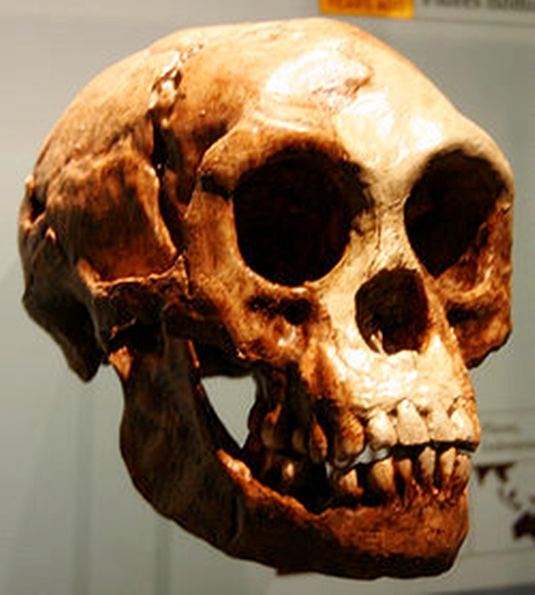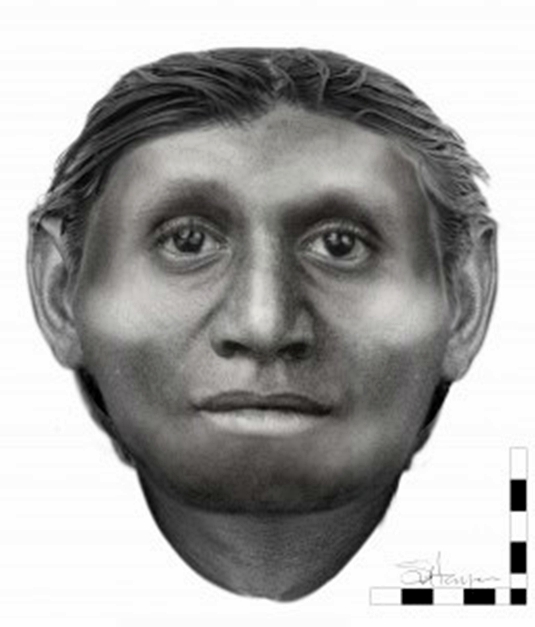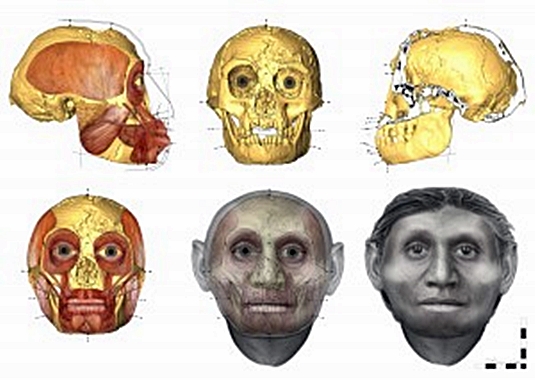It looks like you're using an Ad Blocker.
Please white-list or disable AboveTopSecret.com in your ad-blocking tool.
Thank you.
Some features of ATS will be disabled while you continue to use an ad-blocker.
share:

Hi ATS!
While this isn't my usual playground on ATS - it is a forum I read often and I spend a lot of my non-ATS related time reading and watching documentaries on the subjects this forum discusses. Besides, given the fact that a movie release is coinciding with this scientific information - it seemed like the exact right moment to step in and post this!
I felt it was high time I shared and contributed!
Since I first read about Homo floresiensis several years back, I've kind of had a soft spot for the little guy. After all, he is nicknamed The Hobbit - so my modern sensibilities, and cultural influences, tend to force my emotions a bit towards all things hip and Tolkien stories are most definitely hip these days.
For those who do not know, Homo floresiensis is a somewhat contested, possible relative of the human species. From Wikipedia:
Homo floresiensis ("Flores Man", nicknamed "hobbit" and "Flo") is a possible species, now extinct, in the genus Homo. The remains were discovered in 2003 on the island of Flores in Indonesia. Partial skeletons of nine individuals have been recovered, including one complete cranium (skull). These remains have been the subject of intense research to determine whether they represent a species distinct from modern humans, and the progress of this scientific controversy has been closely followed by the news media at large. This hominin is remarkable for its small body and brain and for its survival until relatively recent times (possibly as recently as 12,000 years ago). Recovered alongside the skeletal remains were stone tools from archaeological horizons ranging from 94,000 to 13,000 years ago.
The discoverers (archaeologist Mike Morwood and colleagues) proposed that a variety of features, both primitive and derived, identify these individuals as belonging to a new species, H. floresiensis, within the taxonomic tribe of Hominini. Hominini currently comprises the extant species Homo sapiens (the only living member of the genus Homo), bonobo (genus Pan), and chimpanzee (genus Pan); their ancestors; and the extinct lineages of their common ancestor. The discoverers also proposed that H. floresiensis lived contemporaneously with modern humans on Flores.
Doubts that the remains constitute a new species were soon voiced by the Indonesian anthropologist Teuku Jacob, who suggested that the skull of LB1 was a microcephalic modern human. Two studies by paleoneurologist Dean Falk and her colleagues (2005, 2007) rejected this possibility. Falk et al. (2005) has been rejected by Martin et al. (2006) and Jacob et al. (2006), but defended by Morwood (2005) and Argue, Donlon et al. (2006).
Two orthopedic researches published in 2007 both reported evidence to support species status for H. floresiensis. A study of three tokens of carpal (wrist) bones concluded there were similarities to the carpal bones of a chimpanzee or an early hominin such as Australopithecus and also differences from the bones of modern humans. A study of the bones and joints of the arm, shoulder, and lower limbs also concluded that H. floresiensis was more similar to early humans and apes than modern humans. In 2009, the publication of a cladistic analysis and a study of comparative body measurements provided further support for the hypothesis that H. floresiensis and Homo sapiens are separate species.
Critics of the claim for species status continue to believe that these individuals are Homo sapiens possessing pathologies of anatomy and physiology. A second hypothesis in this category is that the individuals were born without a functioning thyroid, resulting in a type of endemic cretinism (myxoedematous, ME)
Source

Homo floresiensis skull

Site, on Flores, where the skull was found
My personal, non-professional opinion ( or maybe hope ) is that this is a unique and separate species. That, to me, opens the door to a much broader history than the current, more restrictive models of exodus from Africa tend to imply.
With that background information, I give you an article from Scientific American regarding a startling facial reconstruction done recently on the Hobbit's skull:
Reconstructed Face of Extinct “Hobbit” Species Is Startlingly Humanlike
Once upon a time a tiny human species with large feet shared the planet with our own kind. It hunted giant rats and miniature cousins of the elephant, defended its kills from monstrous storks and dodged fearsome dragons. This is not the plot of a lost Tolkien book. This really happened. I’m referring, of course, to our extinct relative Homo floresiensis, which lived on the island of Flores in Indonesia as recently as 17,000 years ago and has for obvious reasons been dubbed the hobbit. It turns out that despite the species’ small size, it may have looked rather familiar, according to a scientific reconstruction.
The Flores hobbit is known best from a relatively complete skeleton of an adult female known as LB1 who stood roughly a meter tall and possessed a brain less than a third of the size of our own.
One intriguing theory holds that the hobbits may indicate that human ancestors left Africa far earlier than previously supposed. Conventional wisdom holds that the australopithecines never made it out of the mother land, leaving it to taller, larger-brained Homo to colonize the rest of the old world. But maybe, some researchers have suggested, the hobbits were a remnant population of australopithecine that made it out of Africa early on.
Ladies and Gentlemen, I present you with, The Hobbit

The process used in reconstruction:

That is a face that really wouldn't stand out too much, even today. So human! Even with all of the controversy and arguing about whether or not this is a legitimate, lost cousin to humanity. Looking at her face leaves me filled with empathy and intrigued!
Hopefully other ATS'ers will find this story and subject as enjoyable and intriguing as I do. To think that the vastness of human history may be so much more involved that we are currently aware. Even to such a degree that our own greatest authors of fiction - and their greatest creations of imagination - prove out to be just part of the grand scheme. That reality could be as potent and powerful as it's fictional counterpart?
If only we'd own up to the reality that we don't really know all that we like to think we do. Huh?
Amazing!
~Heff
edit on 12/12/12 by Hefficide because: (no reason given)
SnF Heff; was a great read and I'm quite fond of the little guys myself.
Fascinating! But...did they have furry feet and names like Frodo and Bilbo?
Seriously, great find and a great read!
Seriously, great find and a great read!
LOL he looks like one of those little wanted peruvian, mexican felons
reply to post by BacknTime
It's a SHE..
And I wonder why the cave was so friggin massive, even by our standards, that the wee little H Flor's used it for a home.
I swear Gandalf bumped his head a few times inside BagEnd..
It's a SHE..
And I wonder why the cave was so friggin massive, even by our standards, that the wee little H Flor's used it for a home.
I swear Gandalf bumped his head a few times inside BagEnd..
Nice thread!
You know, I've read that Tolkien was trying to create a 'Unified Mythology' with his stories. Creatures like the Gollum and the nine rings of power are taken from Norse Mythology. So I'd be curious to find his source for the Hobbits in his story. There may be more to this.
You know, I've read that Tolkien was trying to create a 'Unified Mythology' with his stories. Creatures like the Gollum and the nine rings of power are taken from Norse Mythology. So I'd be curious to find his source for the Hobbits in his story. There may be more to this.
reply to post by Hefficide
Sometimes fact is stranger than fiction
There is a history before the history we are aware of.
Great presentation.
I've read speculation that the Hobbit may have migrated both into Africa and maybe to the new world since we find "Pigmy" sized modern man in those two locations and elsewhere....
Interbreeding eh?
Sometimes fact is stranger than fiction
There is a history before the history we are aware of.
Great presentation.
I've read speculation that the Hobbit may have migrated both into Africa and maybe to the new world since we find "Pigmy" sized modern man in those two locations and elsewhere....
Interbreeding eh?
OK, so this is interesting. Tolkien has been accredited for coining the word Hobbit. But being a linguist, Tolkien was cautious in accepting credit.
He remembered coming up with the term while writing his Middle Earth stories, but what he did was break down the roots of words that people used to
use when describing his characters. Therefore, he says that he may not have been the first to use it...and he was right. As it turns out, it shows up
in a 19th century English Folklore Journal as a word used to describe...
You guessed it, little people.
en.m.wikipedia.org...(word)
Wow. Stuff like this is why LOTR and the Middle Earth tales in general are some of the most fascinating reads available.
And more to the point of the thread, we may be dealing with a verified mythological 'creature' in this thread.
You guessed it, little people.
en.m.wikipedia.org...(word)
Wow. Stuff like this is why LOTR and the Middle Earth tales in general are some of the most fascinating reads available.
And more to the point of the thread, we may be dealing with a verified mythological 'creature' in this thread.
reply to post by funnychick
Pygmy is just a classification of height kinda between average sized and midget.
Pygmy is just a classification of height kinda between average sized and midget.
reply to post by funnychick
Pygmies are not a separate species, they are homo sapiens - and:
Source
Homo floresiensis is a full 20 inches shorter than that standard and is considered a separate species based upon analysis of the skull and brain size:
Source
~Heff
Pygmies are not a separate species, they are homo sapiens - and:
Pygmy is a term used for various ethnic groups worldwide whose average height is unusually short; anthropologists define pygmy as any group whose adult men grow to less than 150 cm (59 inches) in average height. A member of a slightly taller group is termed "pygmoid." The best known pygmies are the Aka, Efé and Mbuti of central Africa. There are also pygmies in Australia, Thailand, Malaysia, the Andaman Islands Indonesia, the Philippines, Papua New Guinea, and Brazil. The term also includes the Negritos of Southeast Asia.
Source
Homo floresiensis is a full 20 inches shorter than that standard and is considered a separate species based upon analysis of the skull and brain size:
In addition to a small body size, H. floresiensis had a remarkably small brain. The brain of the holotype LB1 is estimated to have had a volume of 380 cm3 (23 cu in), placing it at the lower range of chimpanzees or the extinct australopithecines. LB1's brain size is half that of its presumed immediate ancestor, H. erectus (980 cm3 (60 cu in)). The brain to body mass ratio of LB1 lies between that of H. erectus and the great apes. Insular dwarfism has been posited to explain the brain size reduction. Scientists at the Natural History Museum in London have found that the reduction in brain size of extinct pygmy hippopotamuses in Madagascar compared with their living relatives is greater than the reduction in body size, and similar to the reduction in brain size of H. floresiensis compared with H. erectus.
Source
~Heff
reply to post by Hefficide
news.discovery.com...
"It's not just that their brains are small; they're differently shaped. It's its own species."
news.discovery.com...
reply to post by Hefficide
Well Well.....
Great thread Heff !
Do you think that these "Hobbits" were stuck only in Indonesia ?
BTW,Gandalf approves of DNA sequencing and cloning.
Well Well.....
Great thread Heff !
Do you think that these "Hobbits" were stuck only in Indonesia ?
BTW,Gandalf approves of DNA sequencing and cloning.
reply to post by sonnny1
I think that the Indonesian tribe may have a lost string in an early exodus eastward. Science is funny regarding the eastward migrations - and geneticists still get a bit woogy when you bring up the Aboriginals in Australia - or the ideas of an early, eastward Pacific, island to island expansion that predates the accepted "out of Africa" model.
~Heff
I think that the Indonesian tribe may have a lost string in an early exodus eastward. Science is funny regarding the eastward migrations - and geneticists still get a bit woogy when you bring up the Aboriginals in Australia - or the ideas of an early, eastward Pacific, island to island expansion that predates the accepted "out of Africa" model.
~Heff
reply to post by Hefficide
An outside the box theory fits just as well, as any of the rest out there. Im open minded. The air flows smooth between the ears.......
No one really knows, until proof is found, hey?
BTW, I await patiently for your "Dragon" find............
An outside the box theory fits just as well, as any of the rest out there. Im open minded. The air flows smooth between the ears.......
No one really knows, until proof is found, hey?
BTW, I await patiently for your "Dragon" find............
Don't the eye sockets suggest his eyes were larger? giving him an even weirder, less modern human look?
reply to post by Hefficide
Honestly, I think they are just the bones of the ancestors of real life actual people commonly referred to as pygmies.
Honestly, I think they are just the bones of the ancestors of real life actual people commonly referred to as pygmies.
Great thread, Hef! SnF.
The origins of humankind have always intrigued me. I think we "remember" these times as part of the Collective Unconscious that we regurgitate them as myths, or sacred stories, ala "The Lord of the Rings".
Looking forward to reading more!
The origins of humankind have always intrigued me. I think we "remember" these times as part of the Collective Unconscious that we regurgitate them as myths, or sacred stories, ala "The Lord of the Rings".
Looking forward to reading more!
reply to post by skepticconwatcher
Well of course they were once real life actual people. But it seems they weren't Pygmies.
Well of course they were once real life actual people. But it seems they weren't Pygmies.
new topics
-
The Party of Peace - Trump Cabinet Picks Targeted with Death Threats
US Political Madness: 52 minutes ago -
V.P. Kamala Harris releases a video and nobody understands why
US Political Madness: 3 hours ago -
D.B. Cooper mystery may be solved
General Conspiracies: 8 hours ago
top topics
-
D.B. Cooper mystery may be solved
General Conspiracies: 8 hours ago, 18 flags -
V.P. Kamala Harris releases a video and nobody understands why
US Political Madness: 3 hours ago, 13 flags -
The Party of Peace - Trump Cabinet Picks Targeted with Death Threats
US Political Madness: 52 minutes ago, 5 flags
active topics
-
V.P. Kamala Harris releases a video and nobody understands why
US Political Madness • 32 • : Xtrozero -
I thought Trump was the existential threat?
World War Three • 95 • : some_stupid_name -
Well, here we go red lines crossed Biden gives the go ahead to use long range missiles
World War Three • 401 • : Xtrozero -
Interesting Video-UFO?
Aliens and UFOs • 19 • : Schmoe3755 -
The Party of Peace - Trump Cabinet Picks Targeted with Death Threats
US Political Madness • 3 • : matafuchs -
Post A Funny (T&C Friendly) Pic Part IV: The LOL awakens!
General Chit Chat • 7835 • : underpass61 -
Petition Calling for General Election at 564,016 and rising Fast
Political Issues • 100 • : Oldcarpy2 -
Federal law trumps state and local law every time
Social Issues and Civil Unrest • 32 • : marg6043 -
Results of the use of the Oreshnik missile system in Dnepropetrovsk
World War Three • 243 • : Oldcarpy2 -
D.B. Cooper mystery may be solved
General Conspiracies • 20 • : Flyingclaydisk
